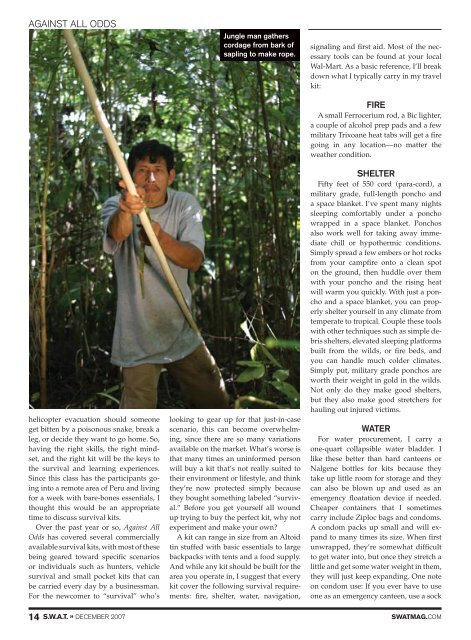S.W.A.T. December 2007 - McKeesport Police Department
S.W.A.T. December 2007 - McKeesport Police Department
S.W.A.T. December 2007 - McKeesport Police Department
You also want an ePaper? Increase the reach of your titles
YUMPU automatically turns print PDFs into web optimized ePapers that Google loves.
AGAINST ALL ODDS<br />
helicopter evacuation should someone<br />
get bitten by a poisonous snake, break a<br />
leg, or decide they want to go home. So,<br />
having the right skills, the right mindset,<br />
and the right kit will be the keys to<br />
the survival and learning experiences.<br />
Since this class has the participants going<br />
into a remote area of Peru and living<br />
for a week with bare-bones essentials, I<br />
thought this would be an appropriate<br />
time to discuss survival kits.<br />
Over the past year or so, Against All<br />
Odds has covered several commercially<br />
available survival kits, with most of these<br />
being geared toward specific scenarios<br />
or individuals such as hunters, vehicle<br />
survival and small pocket kits that can<br />
be carried every day by a businessman.<br />
For the newcomer to “survival” who’s<br />
Jungle man gathers<br />
cordage from bark of<br />
sapling to make rope.<br />
looking to gear up for that just-in-case<br />
scenario, this can become overwhelming,<br />
since there are so many variations<br />
available on the market. What’s worse is<br />
that many times an uninformed person<br />
will buy a kit that’s not really suited to<br />
their environment or lifestyle, and think<br />
they’re now protected simply because<br />
they bought something labeled “survival.”<br />
Before you get yourself all wound<br />
up trying to buy the perfect kit, why not<br />
experiment and make your own?<br />
A kit can range in size from an Altoid<br />
tin stuffed with basic essentials to large<br />
backpacks with tents and a food supply.<br />
And while any kit should be built for the<br />
area you operate in, I suggest that every<br />
kit cover the following survival requirements:<br />
fire, shelter, water, navigation,<br />
signaling and first aid. Most of the necessary<br />
tools can be found at your local<br />
Wal-Mart. As a basic reference, I’ll break<br />
down what I typically carry in my travel<br />
kit:<br />
FIRE<br />
A small Ferrocerium rod, a Bic lighter,<br />
a couple of alcohol prep pads and a few<br />
military Trixoane heat tabs will get a fire<br />
going in any location—no matter the<br />
weather condition.<br />
SHELTER<br />
Fifty feet of 550 cord (para-cord), a<br />
military grade, full-length poncho and<br />
a space blanket. I’ve spent many nights<br />
sleeping comfortably under a poncho<br />
wrapped in a space blanket. Ponchos<br />
also work well for taking away immediate<br />
chill or hypothermic conditions.<br />
Simply spread a few embers or hot rocks<br />
from your campfire onto a clean spot<br />
on the ground, then huddle over them<br />
with your poncho and the rising heat<br />
will warm you quickly. With just a poncho<br />
and a space blanket, you can properly<br />
shelter yourself in any climate from<br />
temperate to tropical. Couple these tools<br />
with other techniques such as simple debris<br />
shelters, elevated sleeping platforms<br />
built from the wilds, or fire beds, and<br />
you can handle much colder climates.<br />
Simply put, military grade ponchos are<br />
worth their weight in gold in the wilds.<br />
Not only do they make good shelters,<br />
but they also make good stretchers for<br />
hauling out injured victims.<br />
WATER<br />
For water procurement, I carry a<br />
one-quart collapsible water bladder. I<br />
like these better than hard canteens or<br />
Nalgene bottles for kits because they<br />
take up little room for storage and they<br />
can also be blown up and used as an<br />
emergency floatation device if needed.<br />
Cheaper containers that I sometimes<br />
carry include Ziploc bags and condoms.<br />
A condom packs up small and will expand<br />
to many times its size. When first<br />
unwrapped, they’re somewhat difficult<br />
to get water into, but once they stretch a<br />
little and get some water weight in them,<br />
they will just keep expanding. One note<br />
on condom use: If you ever have to use<br />
one as an emergency canteen, use a sock<br />
1 S.W.A.T. » DECEMBER <strong>2007</strong> SWATMAG.COM


